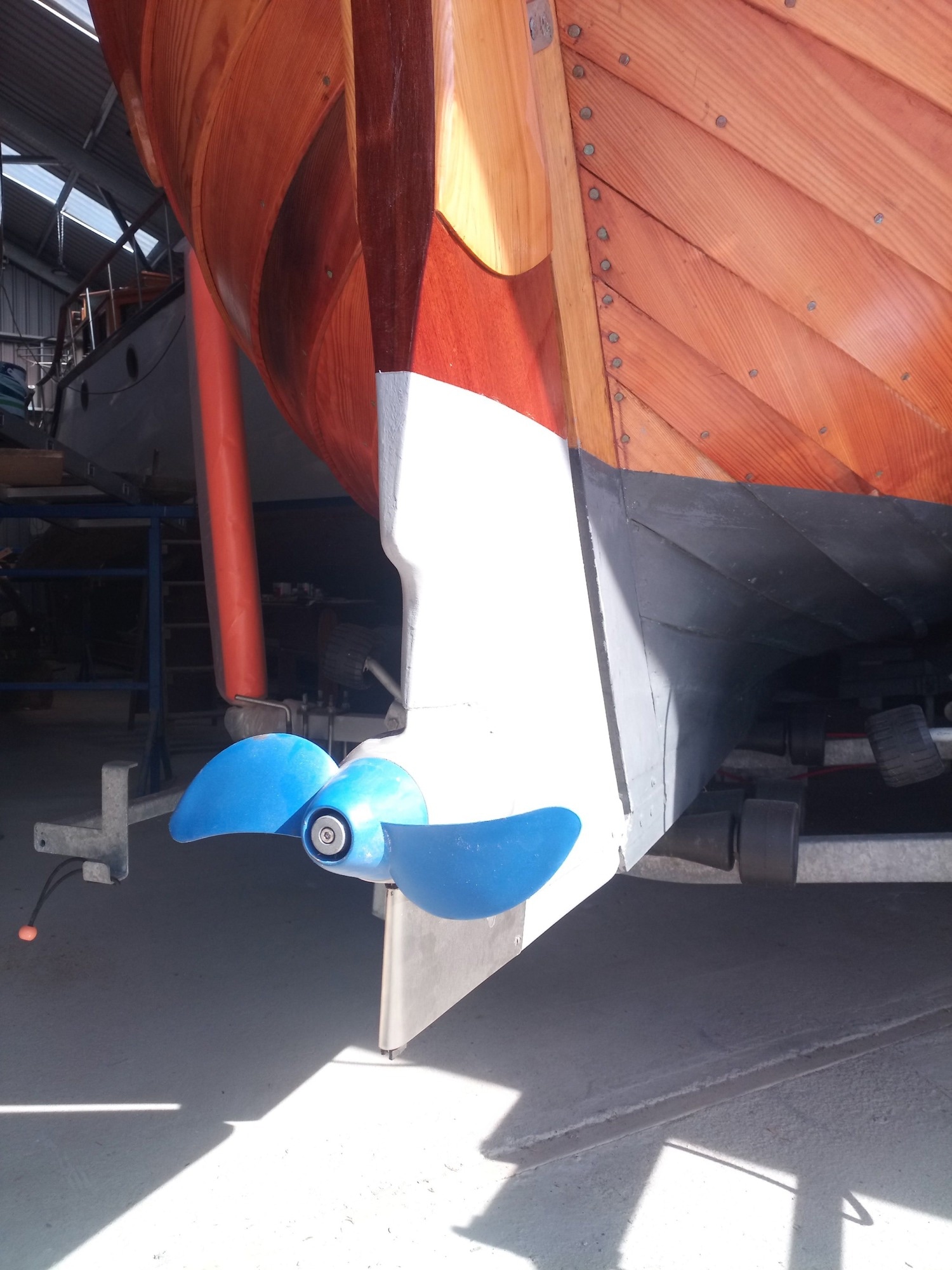A Scottish boatbuilder, A & R Way Ltd (Lochgilphead), has embedded an electric propulsion system into a rudder on a new build Oban Skiff. Adam Way made a replica rudder with a core of Sapele and cheeks of larch, with an ePropulsion Spirit 1 Evo Remote inside.
 LOW RES A and R Way Boatbuilding embedded rudder using WEST SYSTEM. Image Credit: WEST SYSTEM
LOW RES A and R Way Boatbuilding embedded rudder using WEST SYSTEM. Image Credit: WEST SYSTEM
Adam dismantled, rebuilt and reconfigured the propulsion unit and then used WEST SYSTEM epoxy to seal it inside the rudder. He used 105 epoxy resin with 205 hardener and 406 Colloidal Silica (a thickening additive).
Now the boat runs like a dream and no one sailing by could tell that the beautiful 1880s design skiff has an electric secret. The propeller peaks out the bottom of the rudder, the controller is under the seat and the LCD screen is inside the boat. The battery clips into the boat's centre.
Having the propulsion system in the rudder doesn't appear to have affected steering at all. It has great rudder authority at slow speed.
"We were worried about drag on the propeller and we found that with ePropulsion Spirit models there's less drag on that propeller compared to some of their competitors. Because it’s direct drive there is no gear box, which means it's very smooth turning," says Adam.
Adam says a lot of electric motors are made to emulate petrol outboards but once taken apart the up-top 'clobber' (as he terms the LCD screen, battery and 'so on') can go anywhere in the boat.
"The owner has instant power at the flick of a switch," says Adam. "And, he's not having to carry the outboard to and from the boat, or put up with a cumbersome and unsightly unit clamped to the round stern. He just unclips the battery and takes it home for charging." Adam says the battery is about the size of a gallon tin.
Of course, Adam couldn't have contemplated the project without WEST SYSTEM epoxy. He's been using WEST SYSTEM products since 1997. "It works, and I know how it reacts to different situations," he says.
The process was straightforward.
Adam says he has been considering how to add electric propulsion to classic boats for a while, and when the skiff's owner was enthusiastic and also happy to take the risk, Adam got on with the job. In total he calculates the rudder conversion took four days.
"The biggest challenge was getting the design right," he says. "I drew it out several times at full size, until I thought 'that'll work'.
"The deconstructing was a bit worrying because I had a brand-new item [the ePropulsion unit], and I had to set-about its outer sheathing with an angle grinder.
"In the core of the leg of the outboard is a round tube, which we left intact with manufacturer's seals on it to keep the water out.
"A particular problem was that the stern of the boat is raked at an extreme angle but the outboard motor propeller is at right angles to its vertical shaft. I needed it to go over to about 60 degrees. So we put it in a hydraulic press and gently squeezed it into the desired smooth curve with multiple pressings. We then hollowed out two halves of timber to snuggly fit around it, and that was put together with WEST SYSTEM epoxy. The wiring was fed out the top of the rudder at the side, then plugs, sockets and controls were fitted."
Adam says the process could work for almost any boat because electric motors are available in all sizes "as long as you can work out a way to keep the motor cool in the water. You could do it on a yacht, a small motorboat or small launches. It doesn't need to be a traditional wooden boat. It would work well in an epoxy glass, or even carbon fibre, rudder. It could be anything," he says.
Oban Skiffs, which Adam makes on commission, are based on a boat built in Oban in the 1880s but the design is similar to other fishing boat types, which were common along the whole of the west of Scotland.
"We're delighted that WEST SYSTEM epoxy is being used to push the boundaries of innovation," says Sam Oliver, General Manager, Wessex Resins. "Particularly in this case as WEST SYSTEM products are being used to help push sustainable technologies forward. We're aware that this isn't the first time an electric propeller has been embedded into a rudder, but this project is a beautiful example of ingenuity and aesthetics combined."
The skiff has a beautiful round stern, fine lines forward flowing into strongly flared sides with a roomy inside and loose footed lugsail main, no boom to hit heads and a jib set on a long bow sprit. It can now come with an embedded electric propulsion system too.
WEST SYSTEM epoxy was created by Gougeon Brothers Inc. in 1969 and since then the resin and hardener formulations have been continually tested and improved to produce the most reliable and well-balanced epoxy systems available. Wessex Resins manufactures WEST SYSTEM products in Romsey, UK under license from Gougeon Brothers.